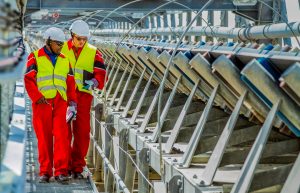Print a Sign-In Sheet | Spanish Version Coming Soon
All establishments covered by KRS 338 are subject to an inspection by an occupational safety and health (OSH) compliance safety and health officer (CSHO).
Types of Compliance Inspections
- Imminent danger – Reasonable certainty that a danger exists that could cause serious physical harm or death.
- Fatality/catastrophe – Reported to the Occupational Safety and Health Administration (OSHA) by the employer if a serious event or fatality occurs.
- Complaints/referrals – A worker or worker representative can file a complaint regarding their safety or a potential health hazard.
- Follow-up – A follow-up inspection from a prior inspection or event.
- Programmed (random) – Inspections that are conducted due to national or local emphasis. Also, it may be conducted due to industries and employers having high injury and illness rates, specific hazards, or other exposures.
Inspection Process
- Opening conference:
- Compliance officer presents credentials.
- Employers have the right to refuse an inspection and request a search warrant.
- Determine employer and employee (if needed) representation.
- The CSHO will explain the nature and scope of the inspection.
- Review paperwork and records.
- Discuss and review walkaround procedures and the area that needs to be reviewed.
- Walkaround:
- Includes employer and union representation (if needed).
- Identify potential violations.
- Videos, photographs, measurements, etc., will be taken for documentation.
- Employees may be interviewed.
- Closing Conference:
- Review recommended/potential violations.
- Review applicable standards.
- Review the post-inspection guide.
- Post-inspection
- CSHO reports findings and makes recommendations in a written report.
- The report is reviewed to determine if a citation will be issued and if a penalty (fine) will be proposed.
- Citation(s) and notices of the proposed penalty are sent to the employer. The citation informs the employer of the alleged violation, penalty, and proposed time for abatement.
- The employer can request an informal conference between employer and Kentucky Office of Occupational Safety and Health (KYOSH) to discuss ways to correct the violation(s) or issues/concerns regarding the citation.
- The employer may also request to contest the citation.
Citations and Penalties
- Willful – A violation that the employer intentionally and knowingly commits or a violation that the employer commits with plain indifference to the law. The maximum penalty for each willful violation is $70,000 and a minimum penalty of $5,000 for each willful violation.
- Serious – A violation where there is a substantial probability that death or serious physical harm could result and that the employer knew or should have known of the hazard. Maximum penalty of up to $7,000 for each serious violation.
- Other–than-Serious – A violation that has a direct relationship to safety and health, but probably would not cause death or serious physical harm. Maximum penalty of up to $7,000 for each other-than-serious violation.
- Repeat – A violation that is the same or similar to a previous violation. The maximum penalty for each repeat violation is $70,000 and a minimum penalty of $500 for each repeat violation.
- Failure to Abate – A violation when a condition previously cited has never been abated. May be accessed a penalty of up to $7,000 for each day the failure continues. Maximum of 30 days.
What Should You Do to be Prepared for an OSHA Inspection?
- Establish and develop a company policy for how to handle an OSHA inspection if it occurs.
- Designate an employee or employees who would handle and facilitate an OSHA inspection. Make sure individuals can make decisions according to policies.
- Ensure information is up-to-date and readily accessible for OSHA to review, such as written safety programs, training documentation, OSHA logs, etc.
- Take pictures and notes during the inspection. If a CSHO takes a picture, then you take the same picture.
- Ask questions and ask if safety violations can be taken care of during the inspection, then try to correct them immediately.
- Make sure you try to correct or fix the safety violation(s). Remember, employee safety is the primary objective.
KEMI does not assume liability for the content of information contained herein. Safety and health remain your responsibility. This information is to be used for informational purposes only and not intended to be exhaustive or a substitute for proper training, supervision, or manufacturers’ instructions/recommendations. KEMI, by publication of this information, does not assume liability for damage or injury arising from reliance upon it. Compliance with this information is not a guarantee or warranty that you will be in conformity with any laws or regulations nor does it ensure the absolute safety of any person, place, or object, including, but not limited to, you, your occupation, employees, customers, or place of business.

